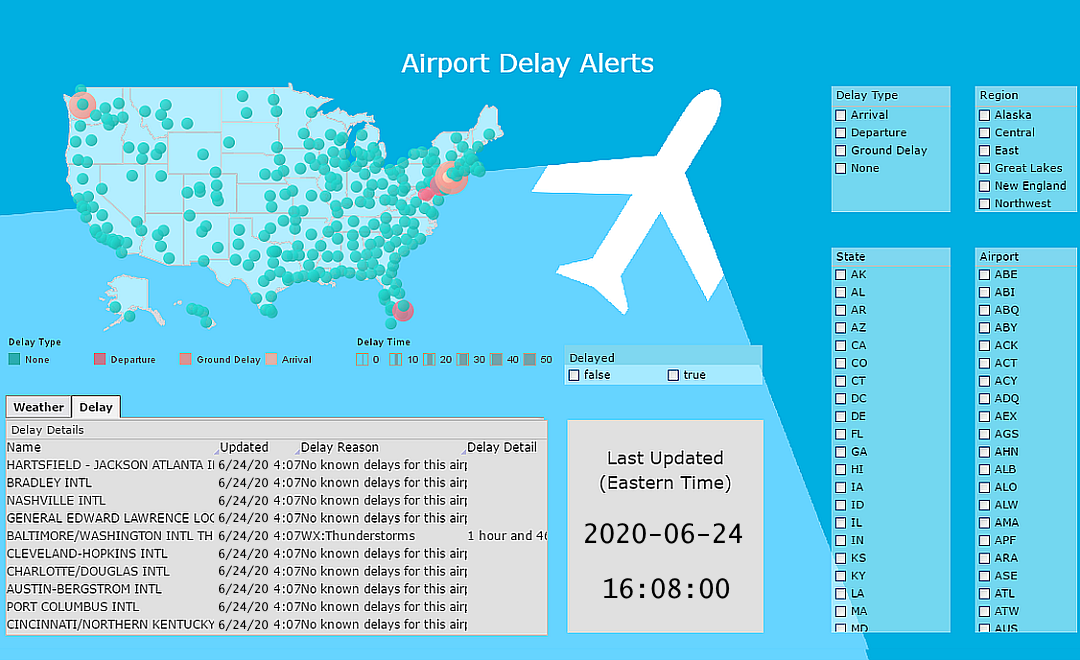What KPIs and Analytics Do Airline Operations Professionals Use?
Even the smallest inefficiency or delay may have serious repercussions in the highly competitive and sophisticated aviation business. As a result, experts in airline operations are always searching for methods to streamline their processes and raise their performance.
Professionals in airline operations employ key performance indicators (KPIs) and analytics as crucial tools to accomplish these objectives. We will examine the KPIs and analytics used by airline operations specialists to manage their operations in this post.
| #1 Ranking: Read how InetSoft was rated #1 for user adoption in G2's user survey-based index | Read More |
KPIs for Airline Operations
KPIs are quantifiable metrics that show how well a firm is reaching its goals. The most crucial KPIs for airline operations are those that measure the efficacy and efficiency of the airline's operations. Typical KPIs for these metrics are:
On-Time Performance (OTP)
One of the most important KPIs for airlines is OTP. It calculates the proportion of flights that reach their destination on schedule. OTP is a critical component of customer satisfaction and is used by airlines as a gauge of their performance and dependability. An airline that continuously has a high OTP is more likely to draw in new passengers and keep up a good reputation.
Load Factor
The load factor gauges how crowded an airline's flights are. By dividing the number of people on the aircraft by the total number of seats that are available, it is determined. As a measure of their profitability, load factors are something that airlines strive to optimize. A high load factor indicates that a large portion of the airline's tickets are being sold, which results in more income.
Flight Utilization
The amount of time an aircraft is in operation each day is measured by its flight utilization. To improve the number of flights they can operate with their current fleet, airlines strive to enhance flight utilization. An airline that has a high flight utilization rate is using its planes to generate more income.
Revenue Passenger Kilometers (RPK)
The number of kilometers flown by paying passengers is shown as RPK. RPK serves as a measure of airline revenue generating. An airline will create more income the more RPK it produces.
 |
Learn about the top 10 features of embedded business intelligence. |
Business Objectives
The process of utilizing data to find patterns, trends, and insights that may be utilized to boost corporate performance is known as analytics. The ability to discover areas where operations might be optimized makes analytics a crucial tool for airline operations experts. Some of the most significant analytics employed by experts in airline operations include the following:
Network Optimization
The process of network optimization entails employing data analytics to determine the aircraft schedules and routes that are the most cost-effective for an airline. This procedure takes into consideration variables including flight durations, fuel use, the availability of aircraft, and passenger demand. An airline may boost productivity and save expenses by improving its network.
Crew Scheduling
The difficult process of crew scheduling requires combining the requirements of the airline with the preferences and availability of the crew members. Airlines enhance crew scheduling using data analytics, taking into account elements including staff credentials, seniority, and work hours. Airlines can save expenses and raise the standard of living for their crew members by improving staff scheduling.
Maintenance Planning
To keep aircraft in top shape and safe to operate, maintenance planning includes scheduling maintenance. Airlines improve their maintenance schedules using data analytics, taking into consideration things like aircraft utilization, maintenance history, and legal requirements. Airlines can save maintenance expenses and limit aircraft downtime by improving maintenance planning.
 |
Learn the advantages of InetSoft's small footprint BI platform. |
Revenue Management
The practice of adjusting an airline's price and inventory in order to increase revenue is known as revenue management. Airlines employ data analytics to pinpoint demand trends and modify their inventory and price as necessary. Airlines may boost their revenue and profitability by improving their revenue management.
Customer Satisfaction
Customer satisfaction is a metric for gauging how happy consumers are with their whole airline experience. Scores on customer satisfaction are used by airlines to identify areas for development and evaluate the success of their customer service programs.
Baggage Handling
An airline's baggage handling performance is a gauge of how successfully it manages checked luggage. This KPI comprises measurements like the quantity of misplaced or delayed luggage and the amount of time it takes to deliver bags to passengers at their destination. Airlines strive to deliver luggage to customers as fast as possible and reduce the amount of bags that are lost or delayed.
Aircraft Turnaround Time
The time it takes for an aircraft to land, load and unload passengers and luggage, clean the cabin, refuel, board passengers, and take off is known as the aircraft turnaround time. In order to maximize aircraft use and save expenses, airlines strive to shorten turnaround time.
Analytics for Airline Operations
Predictive Maintenance
Predictive maintenance employs data analytics to spot possible problems with equipment, including airplanes, before they arise. Airlines can forecast when maintenance is required and take preventative action to fix problems before they result in delays or cancellations by evaluating data from sensors and other sources.
Flight Path Optimization
Data analytics is used in flight path optimization to determine the best flying paths and altitudes. Airlines may improve on-time performance while lowering fuel use, emissions, and noise pollution by optimizing flight patterns.
Crew Performance Management
Crew performance management tracks crew performance and identifies opportunities for improvement using data analytics. Through focused training and coaching, airlines may increase the performance and work satisfaction of their crew members.



